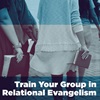Many churches, with purity of heart, discuss the success of their small group ministry based on the numbers, typically the percentage of people 'connected' in small groups. Numbers can be an indication of success, but we can be misguided by them too. For example, we cannot presume that we are SUPPOSED to connect 100% of our congregation with other members of our congregation.
People may already have nurturing, Christ-focused relationships OUTSIDE of your church. In fact, equipping members to become connected with the unchurched in your area can accelerate a sense of life-giving community with God and others. What if we were to empower people in becoming more effective at introducing and emitting the aroma of Christ within the relational circles they already have (2 Corinthians 2:14-15). Instead of redefining their relational commitments, we validate what they are already doing 'in the world'. We equip them to "plant" a small group where they already are by helping them to naturally bring their faith to their friendships. Cross-pollinating over transplanting!
It is important that church leaders are critical about the goals they set and how success is measured. Small groups are not an end unto themselves. If the goal is to build life-giving community and engage in mission (not mutually-exclusive activities), then the metrics for measurement need to be broadened to include life-change, outreach, conversions, etc. If it is true that the number of people in small groups is an insufficient measurement of success, then it is questionable if it is acceptable to make this the primary goal of a small group ministry.
Church leaders like to track things, but I give particular caution to doing this with small groups. Unless a church has a clear plan for how they plan to use the data they would like to collect, I discourage developing a small group database. The question we need to ask ourselves is WHY do we want the data? HOW do we intend to use it?
The truth is I am not aware of most of the small groups happening in the church where I serve as a pastor. I realize that must sound awfully irresponsible to some! We create profiles on the groups we know meet on a regular basis, and we post them in an area of our foyer we call The Gathering Place. We continually let people know they can join existing groups listed or start a new one. We manage our small group resources so they can be shared. There is a purpose in whatever we take time to track. As a result, I can tell you roughly how many groups meet on a regular basis and I can assess trends within our small group ministry, but I do not know precisely how many groups we have.
For example, four years ago, our church was 300 adults and had 3 small groups. Today it is 2,300 adults and, as far as I am aware, our church has over 120 groups (not including ministry/task groups) and well over half of our adult population is involved in a church-sponsored small group. I cannot tell you who and how many are in which groups. I cannot tell you how many good friendships have been created as a result of people being in small groups.
There are many people who have struck up friendships in their small groups and they meet outside of their small groups too. (These are groups too, are they not?) I love to hear things like that, and I do not HAVE to know the details. I just like to know it is happening. It is a sign things are working as they should.
I have tried to keep complete, up-to-date lists and track groups and attendees in a church database. It is a lot of work, and it is continuous work being that a church's small group ministry is always in flux. The moment I think I have got a handle on "the numbers of leaders, participants, and guests," they change…as they ought to. I would be concerned if things stopped moving around on me. Movement and change are both key indicators that an organism is, in fact, living and healthy. Fear of such may be part of the problem in dying churches.
Back to this point: The goal is not to get people into small groups. The goal (as frustrating as this is for many) is not something tangible and objective that can be measured. The goal is the vibrant life that comes from people experiencing life-giving community with God and others. It is hard to measure, but it can be felt.
When it is happening, you see people saved, healed, delivered, and restored (Isaiah 61:1-2). Lives are being transformed because the power of the Gospel is penetrating and rooting itself in the soil of human hearts as a result of the Acts 2 dynamic of the Church coming alive through small groups.
If you were to ask me how many people in our church are "connected", I would tell you, "Most are." If you were to ask me how many groups our church has, I would tell you the ones I know about. If you were to ask me if we are happy with how things are going with our small group ministry, I would tell you, "Absolutely!" If you were to ask me why, I would invite you to come and experience the vibrant life of a community that is standing together in awe of God's amazing grace.
I am far from having a handle on this, but when unorganized, spontaneous connection is happening all around, I would say that, by the grace of God, we are on to something. I believe this is in large part due to the fact that we do not pressure people to get into small groups. We create environments that encourage what we want to see as a result of people being connected with God and one another: Life-giving community. What we are ultimately encouraging is a culture in favor of community, and, as a result, the number of small groups within our church grows organically.
For example, our church utilizes Stanley & Willits' concept of a 'living room event' that is basically an interactive, intermediate event between a weekend worship service and small group that encourages casual connection. These events help to meet people where they are, regardless of their current desire and commitment to connect. The basic idea is that these events will serve as a bridge to facilitate the movement from our large worship services to our small groups where relationship building can occur. They are oriented around a subject of interest (which oftentimes draws a certain affinity group) that will be presented live or via video. Then, we arrange for table group discussions based on the teaching content.
How we do it is by creating a fun environment where people can BEGIN to connect relationally. We offer food, provide childcare, and find a way to 'plug' small groups in a non-obligatory fashion. We recruit existing small group leaders to serve as table hosts who encourage conversation and connection. For example, we showed The Passion of The Christ movie by Mel Gibson on Palm Sunday and are presently offering 3-week discussion groups where people can continue to explore themes and figures in the film. We also featured a couple of CCN broadcast events that included a video presentation, table group discussion, and optional 3-6 week small groups that people joined in order to continue their conversation about the subject matter that began at the event.
We are continually on the lookout for things that are generating spiritual conversations in our culture like The Da Vinci Code so we can use them to 'mix' believers with seekers in hope of cultivating an environment where the Acts 2 life-giving dynamic can flourish. The first week of June (a couple weeks after the release of the movie based on the novel) our church will host seminars with table group discussions where people will have the option to continue exploring questions the now popular novel has raised about Jesus, the Bible, the Church, etc.
The idea is that these groups will serve as a starting point, or springboard, to help people begin building relationships with others who share a common interest. The hope is that this will encourage the development of genuine friendships and life-giving community with God and others. This may or may not lead to the formation of a small group. Again, the goal is for people, at all different places in their spiritual journey, to experience in increasing measure the vibrant life of Christ-focused relationships with God and others. You can take this to the next level by inviting each staff person, key ministry leader, or coach to conduct 'living room events' relevant to their area of ministry.
How these interactive environments are designed and what they look like will be unique to each church. There are similarities in calling and ministry demographics for churches, so opportunities abound for learning from each other. I believe we are at the beginning of an exciting new era in how the Church can creatively use such community-building events to enliven the Body of Christ and extend life to those who have yet to begin a relationship with the Lord!









